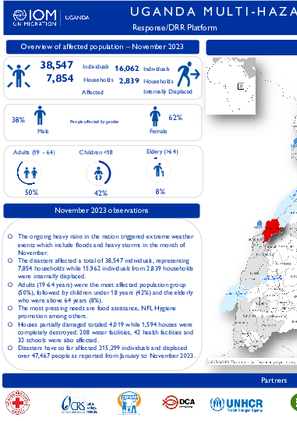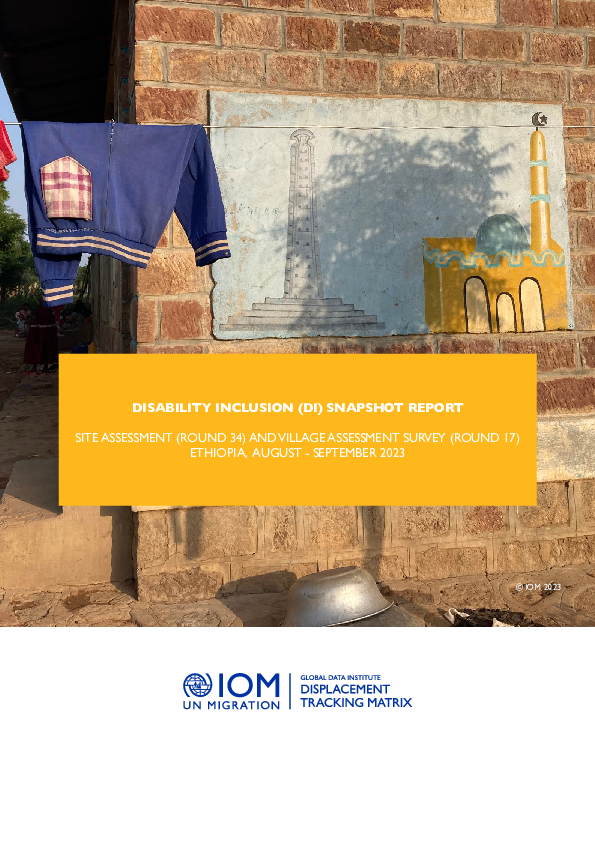-
Countries
-
Data and Analysis
-
Special Focus
-
Crisis Responses

Contact
DTM Uganda, dtmuganda@iom.int
Language
English
Location
Uganda
Period Covered
Nov 01 2023
Nov 30 2023
Activity
- Mobility Tracking
The ongoing heavy rains in the nation triggered extreme weather events which include floods and heavy storms in the month of November.
o The disasters affected a total of 38,547 individuals, representing 7,854 households while 15,962 individuals from 2,839 households were internally displaced.
o Adults (19-64 years) were the most affected population group (50%), followed by children under 18 years (42%) and the elderly who were above 64 years (8%).
o The most pressing needs are food assistance, NFI, Hygiene promotion among others.
o Houses partially damaged totaled 4,019 while 1,594 houses were completely destroyed. 208 water facilities, 42 health facilities and 32 schools were also affected.
o Disasters have so far affected 215,299 individuals and displaced over 47,467 people as reported from January to November 2023.

Contact
IOMDTMPoland@iom.int
Language
English
Location
Poland
Period Covered
Sep 01 2023
Nov 30 2023
Activity
- Survey
In March of 2023, IOM Poland launched its Integration Survey to assess the progress and needs relating to labour and social integration of refugees from Ukraine in Poland.
The aim of the assessment is to gain an understanding of the employment situations, housing needs, financial resilience, social cohesion, barriers to accessing services, and short-medium term needs of refugees. In the 1 September - 30 November 2023 period, a total of 1,232 surveys were conducted.
This report provides a snapshot of the social integration of Ukrainian refugees in Poland for the period of September through November of 2023, as well as an overview of key trends based on data collected from March 2023 through November (page 2).
Key Findings
- The length of time spent in Poland is a significant determinant of the level of social integration of respondents. Those who had lived in Poland for more than 12 months at the time of interview had a higher average social integration score* (0.32) compared to those who had lived in Poland for less than 12 months (0. 23).
- The level of social integration reduced consistently as the age of respondents increased, with those 18–24 years old having a much higher average score (0.40), and those over 65 having a lower average score (0.24).
- Students, business owners, and those employed full-time had the highest levels of social integration (>0.39), as compared to those who were retired, unemployed, or carried out family responsibilities, who had the lowest scores (<0.22).

Contact
DTM Ethiopia, DTMEthiopia@iom.int
Language
English
Location
Ethiopia
Period Covered
Aug 01 2023
Sep 02 2023
Activity
- Mobility Tracking
- Site Assessment
- Village Assessment
Between August and September 2023, the International Organization for Migration (IOM), through its Displacement Tracking Matrix (DTM) methodology, deployed the Site Assessment (SA) Round 34 and Village Assessment Survey (VAS) Round 17 assessment tools to assess the mobility, needs and vulnerabilities of Internally Displaced Persons (IDPs) and returning IDPs across Ethiopia.
This snapshot report will present key findings on needs and vulnerabilities, and will focus on obstacles related to accessing shelter/Non-Food Items (ESNFI) and Water, Sanitation and Hygiene (WASH) in the locations assessed through the SA and VAS assessments. The indicators included in the assessments were designed by the Disability Inclusion (DI) expert in country with support from the IOM-DTM team, and aim to shed light on the obstacles that people with difficulties seeing, hearing, walking, communicating and understanding, face in relation to their shelters, accessing distributions and using bathing facilities/latrines. In 61.67% of sites with IDPs, the first obstacle in relation to shelter was physical barriers to enter and leave their home and circulate inside the shelter.

Contact
DTM Ethiopia, DTMEthiopia@iom.int
Language
English
Location
Ethiopia
Period Covered
Aug 01 2023
Sep 02 2023
Activity
- Mobility Tracking
- Site Assessment
- Village Assessment
Between August and September 2023, the International Organization for Migration (IOM), through its Displacement Tracking Matrix (DTM) methodology, deployed the Site Assessment (SA) Round 34 and Village Assessment Survey (VAS) Round 17 assessment tools to assess the mobility, needs and vulnerabilities of Internally Displaced Persons (IDPs) and returning IDPs across Ethiopia.
As part of its commitment to Accountability to Affected Populations (AAP) principles, IOM Ethiopia’s AAP and DTM teams have closely worked together on AAP implementation and mainstreaming in DTM operations. The DTM team reviewed and incorporated indicators related to AAP within the SA and VAS tools, to map communities’ access to feedback mechanisms and involvement in the decision-making process surrounding humanitarian aid. The indicators were included in the August - September 2023 multisectoral assessments which took place nationwide in IDP sites (SA) and villages of return (VAS).
The key findings from the assessments are presented in this snapshot report. Group discussions with IDPs (for SA) and with returning IDPs (for VAS) were asked if members of the target population in the location were aware of mechanisms to provide feedback and make complaints about the quality, quantity and appropriateness of the humanitarian aid they receive. In 59.20% of sites no IDPs in the location were aware of these mechanisms and in 52.56% of villages no returning IDPs were aware.
The current El Niño conditions and the positive Indian Ocean Dipole have brought increased rains in most parts of the East and Horn of Africa, causing riverine and flash floods. The most affected countries have been Somalia (1.7 M), Ethiopia (763 K) and Kenya (475 K), with almost 3 million people affected and over 1.5 million displaced in those countries. Torrential rains also affected critical infrastructure, such as roads, bridges, water sources, and health facilities. This is seriously straining the operational capacity of humanitarian actors to support those most in need. Although the above-average rainfall may help pastoralist communities recover from the 2020–2023 drought, there are also risks of pasture and livestock disease outbreaks that may trigger food insecurity and waterborne diseases. According to the World Meteorological Organization, El Niño conditions are forecast to continue through at least April 2024, while the positive Indian Ocean Dipole is expected to last until February 2024.

Contact
DTM Europe, DTMMediterranean@iom.int
Language
English
Location
Latvia
Period Covered
Jul 01 2023
Sep 30 2023
Activity
- Survey
- Return Intention
Key Findings
- Top 3 countries of stay abroad: Poland (34%), Germany (21%), Russian Federation (15%)
- Oblasts of origin: Donetska (27%), Luhanska (21%), Zaporitzka (14%).
- Destinations in Ukraine: going to same oblast of origin (90%), to a different oblast (8%)
- Intentions after arrival to Ukraine: long-term stay (48%), short-term visit (24%), 28% do not know.
- Top needs on the way to Ukraine:* general information (84%), food supply (11%), short-term accommodation (2%).
- Top areas of assistance received:* financial support (92%), accommodation (70%), food (59%)
* more than one answer possible

Contact
DTM Burundi, DTMBurundi@iom.int
Language
English
Location
Burundi
Period Covered
Oct 01 2023
Nov 30 2023
Activity
- Survey
- Return Intention
Depuis 2020, la province de Bujumbura Rural, commune de Mutimbuzi, zone de Gatumba a été récurremment touchée par de fortes inondations affectant plusieurs milliers de personnes. Ces catastrophes naturelles ont engendré des déplacements massifs et la création de sites temporaires d'accueil à Kinyinya II et Sobel (Maramvya) afin de comprendre pleinement l'impact de ces événements et d'élaborer des stratégies de réponse adaptées, l'OIM a lancé une enquête de profilage en octobre 2023. Cette étude méticuleuse a permis de profiler 1 267 ménages déplacés, soit 3 889 personnes, dont certains ont depuis bénéficié d'une assistance pour retourner dans leurs foyers.
L'objectif de cette enquête était double : d'une part, évaluer les besoins immédiats des populations affectées pour orienter l'assistance humanitaire, et d'autre part, recueillir des données pour soutenir la planification à long terme en vue d'une résilience accrue face aux futures crises. Les résultats, qui seront présentés en détail dans ce rapport, révèlent non seulement l'étendue des défis auxquels sont confrontés ces ménages, mais aussi leur résilience et leurs perspectives d'avenir
Contact
DTM Ethiopia, DTMEthiopia@iom.int
Location
Ethiopia
Activity
- Mobility Tracking
- Village Assessment
Period Covered
Aug 01 2023 -Sep 02 2023
Between 01 August and 02 September 2023, IOM’s DTM deployed Site Assessment (SA) Round 34 and Village Assessment Survey (VAS) Round 17, carrying out a multisectoral location assessment. SA is conducted in locations hosting a reported 20 or more IDP households, and the VAS is conducted in locations hosting a reported 20 or more returning IDP households that returned after 1 January 2021. It is to be noted that Amhara region was largely uncovered this round due to increased insecurity, and both the IDP and returning IDP caseloads should likely be higher.According to the data collected through the Village Assessment Survey round 17 between August and September 2023, there were an estimated 2,530,101 returning IDPs (552,773 returning IDP households) across 2,072 assessed, accessible villages in Ethiopia. The highest returning IDP caseloads nationwide were in the regions of Tigray (1,503,141 returning IDPs, 59.41%), Amhara (an estimated 389,937 returning IDPs, 15.41%) and Afar (an estimated 222,894 returning IDPs, 8.81%).
Population Groups
Residents
Returnee (Previously Internally Displaced)
Survey Methodology
Unit of Analysis Or Observation
Admin Area 2
Admin Area 3
Admin Area 4
Community
Site or Location
Type of Survey or Assessment
Key Informant
Keywords
Geographical Scope Partial Coverage
Administrative boundaries with available data
The current dataset covers the following administrative boundaries
Contact
DTM Ethiopia, DTMEthiopia@iom.int
Location
Ethiopia
Activity
- Mobility Tracking
- Site Assessment
Period Covered
Aug 01 2023 -Sep 02 2023
Between 01 August and 02 September 2023, IOM’s DTM deployed Site Assessment (SA) Round 34 and Village Assessment Survey (VAS) Round 17, carrying out a multisectoral location assessment. SA is conducted in locations hosting a reported 20 or more IDP households, and the VAS is conducted in locations hosting a reported 20 or more returning IDP households that returned after 1 January 2021. It is to be noted that Amhara region was largely uncovered this round due to increased insecurity, and both the IDP and returning IDP caseloads should likely be higher.
According to data collected through the Site Assessment round 34 August and September 2023, an estimated 3,459,881 IDPs (701,449 IDP households) were internally displaced across 2,544 assessed, accessible sites in Ethiopia. Conflict is the primary cause of displacement and displaced 2.2 million IDPs (64.66%), followed by drought which displaced an estimated 612,250 IDPs (17.7%). Somali region hosts the highest number of IDPs primarily displaced by drought nationwide (an estimated 410,749 individuals or 67.1% of the national drought caseload), while Tigray region hosts the highest number of IDPs primarily displaced by conflict nationwide (an estimated 943,285 individuals or 42.2% of the national conflict caseload).
Population Groups
IDPs
Survey Methodology
Unit of Analysis Or Observation
Admin Area 2
Admin Area 3
Admin Area 4
Site
Type of Survey or Assessment
Key Informant
Keywords
Geographical Scope Partial Coverage
Administrative boundaries with available data
The current dataset covers the following administrative boundaries

Contact
dtmlebanon@iom.int
Language
English
Location
Lebanon
Period Covered
Oct 10 2023
Dec 19 2023
Activity
- Mobility Tracking
- Baseline Assessment
Since October 8 there has been an increase in cross-border incidents between Israel and Lebanon, resulting in the displacement of people both within the South and elsewhere within the country. Since October 10, the Displacement Tracking Matrix (DTM) has been conducting the daily monitoring of population movements. The objective of the exercise is to inform preparedness and response planning.

